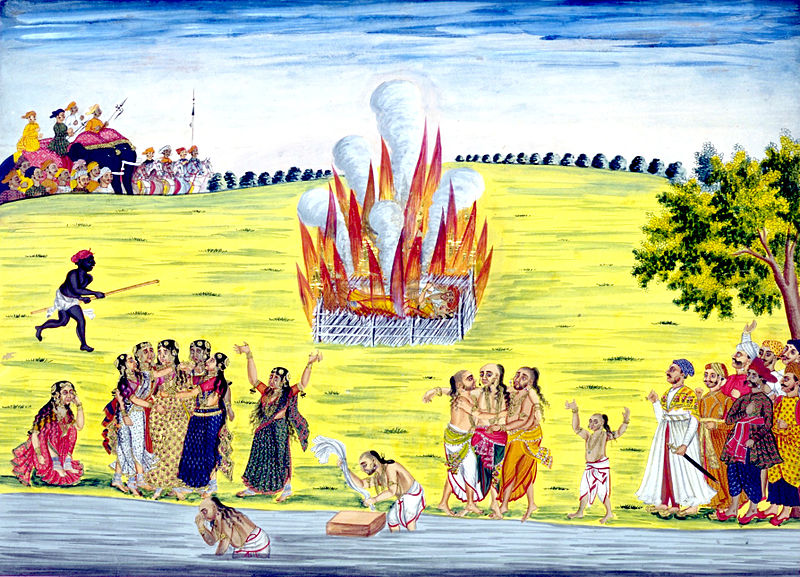Sati, also known as “Suttee,” was a tradition that was practiced in ancient India from the early centuries BCE to the mid-1990’s. In this tradition, widows were burned at the side of their deceased husbands. There were many reasons behind this tragic form of suicide, but the act was seen as heroic and courageous. The tradition originates with the goddess Sati, who burned herself to death in a fire that she created through her yogic powers, which she obtained after her father had insulted her husband. Sati became an option for women in India who were not “marriageable,” according to social norms. Sati was first recognized in the Mahabharata, one of the two most well-known and important poems of India.1
“LAMP of my life, the lips of Death
Hath blown thee out with their sudden breath;
Naught shall revive thy vanished spark . . .
Love, must I dwell in the living dark?” -Suttee by Sarojini Naidu2
The practice of Sati is recounted by a first century BCE Greek author named Diodorus Siculus. Diodorus mentioned sati stones, which were memorials of all of the wives that have passed along with their husbands. A stone was created for each wife after she gave up her life, and these stones were all collected into a shrine. The earliest memorial that has been discovered dates from 510 BCE.3

Another practice that branched out from sati was the Jahuar, which was a sacrifice of any Muslim woman from the twelfth through the sixteenth century. It was believed that if a woman was burned, she would be safe from rape, which was worse than dying at the hands of a conquering enemy.4
Sati was also practiced by the Brahmans of Bengal, by the system of law from 1100 CE, which was called Dayabhaga. If a woman was widowed, her inheritance would be given to the children of her passed husband. If she were to remarry, her inheritance from her deceased husband would be given to the children and her new husband and her other children would not receive anything. If she passed along with her husband, the inheritance would be given to the children of her dead husband. This law was ended by the Mughal rulers Akbar and his father Humayun in the sixteenth century.5
In 1829, when India was informally ruled by Great Britain, the law to make sati illegal was passed because the act was seen by the British as harsh and cruel to women. Although it was made illegal, there were controversies over whether the sati practice was a religious act, and if so, should that be taken into consideration before prohibiting it.2
In 1987, Roop Kanwar, a woman from the village of Deorala in Rajasthan India, was married to her husband for only eight months before he died. She decided against taking her life in front of thousands of people. Politicians and activists believed that Roop Kanwar was then subsequently drugged by the liquid inside the seeds of an opium poppy flower, and pressured to take her life by those around her. Some people even say that she had super natural powers because her eyes were glowing bright red as she burst into flames. Police concluded that a group of men had been guilty of having drugged her, and they were placed under arrest.7
Sati was a rather harsh tradition, but the significance of these rituals was important to many Indian traditions. The thought of self sacrifice in this way is foreign to Western traditions, and the thought of being burned alive is worse. Sati is now illegal and no longer practiced, but the memories of the dead women from this tradition remain and they will always remind us of this social practice.8
- Kashgar, 2009, s.v. “Life in India: the practice of sati or widow burning,” by Linda Heaphy. ↵
- The Denson Journal of Religion, April 2015, s.v. “Interpreting Sati: the Complex Relationship Between Gender and Power in India,” by Cheyenne Cierpial. ↵
- Dorothy Stein, Burning Widows (University of British Columbia: Pacific Affairs, 1988), 466. ↵
- The Denson Journal of Religion, April 2015, s.v. “Interpreting Sati: the complex Relationship Between gender and Power in India,” by Cheyenne Cierpial. ↵
- Encyclopedia Britannica, March 2015, s.v. “Suttee,” by Wendy Dongiger. ↵
- The Denson Journal of Religion, April 2015, s.v. “Interpreting Sati: the Complex Relationship Between Gender and Power in India,” by Cheyenne Cierpial. ↵
- Encyclopedia Britannica March 2015, s.v. “Suttee,” by Wendy Dongiger. ↵
- Sophia Gilmartin, “The Sati, the Bride and the Widow: Sacrificial Woman in the nineteenth century,” Victorian Literature Vol. 25, No.1 (1997): 142. ↵



99 comments
Joshua Castro
This article was extremely interesting! I could never imagine someone willing to burn to death to follow the death of their husband. This is a part of the Indian culture that I will never truly understand no matter how it is explained to me because the level of devotion that is required is one that is rarely found. A question that arose from the reading of this article is whether or not the women would take any medication or do anything to prevent pain or if there were any specific rituals they would perform before their death.
Natalia Flores
I can’t imagine willingly burning myself to death since (in my opinion) it’s one of the worst ways to die, along with drowning. If it was due to social pressures, that would be even worse because these women didn’t want to die. They were forced to go in one of the most painful ways. However, to willingly go after your husband in death by your own choosing is deep.Though, I still wouldn’t burn myself to death. It’s scary to think that even though they made Sati illegal, they still forced Roop Kanwar and other women in modern times to go through this practice.
Anna Guaderrama
Woah, this just gave me a completely new insight onto what sati is. Also, one thing that really stood out to me was the pronunciation – I never would have guessed that that’s how it’s spelled. But, aside from that, it was interesting to read more about the historical aspect of it. Jahuar, was one thing I never even knew existed. But it was intriguing to see that sati has different branches.
Samuel Ruiz
Great article. This practice of Sati surprised me, especially to learn that it occurred up until the 90s. I also found it interesting that no matter what, the children of the passed husband would get the inheritance. I am confused though as to know whether Sati was a choice or an inescapable tradition. However, I did like the inclusion of the conflict the act can cause with the law.
Mohit
This is not the truth. Sati has been started because of muslim invasion in india. Fear of rape and tax started Sati pratha. Akbar and other muslim ruler was responsible of this bad culture. Dont show them a kind ruler who stop Sati ritual. And muslim women never commit jauhar or Sati. Apart from bengal and other myths you mentioned it has been developed after a long history to justify Sati but problem has been started by muslim ruler only
Michael Thomas
I found this article interesting because of how it details the Sati and what brought an end to the Brahman practice. It makes no sense that a woman should sacrifice herself just because she has become a widow. When the British took over, they ended the practice of Sati. I think the British made this law because they witnessed what the people were doing and were trying to spread their influence to the people of India.
Thomas Fraire
This article was very informative on a topic I don’t really have a lot of knowledge on. I really enjoy learning about other cultures and societies that’s why I chose to read this articles. It’s truly saddening though how these women would kill themselves. It is truly intresting how this is a taboo concept to us but for them, it was just part of life, this article was very well researched. Great Job!!
Vanessa Tombo
This article was very enlightening. It allows readers to view into another society’s social conventions and belief system. As I was reading the article, I was in disbelief at the reasons why women killed themselves alongside their husbands. Furthermore, how it had been normalized until the British deemed that law cruel to women. After reading this article I started to question what social norms do we have in our societies today that are cruel and inhuman? Also, have we just normalized them?
Anais Del Rio
I had previously briefly learned about the practice of sati back in one of my history classes so this was a nice refresher as well as a chance to learn more about it. The poor women had no choice in what to do because it was done by countless others and even after it was ruled to be illegal some people bypassed it and this lead to Roop Kanwar being killed. Though I’m curious if at any point the women being burned was offered or took any drugs to lessen to pain or at least pass out before the burning began.
Jasmine Jaramillo
Before reading this article I didn’t even know that this practice existed. It’s so different to hear that the way a widow could be seen as honorable was to be burned alive. I find it interesting how this was the way it was in this culture and how willing women were to be killed for their belief. I’m glad Sati is no longer practiced and that the author gave examples of real life situations where women were targeted.